
|   |

|   |
Dec 22: Mythos, Modernity & Masculinity - Kiran Rajagopalan e-mail: kiran.rajagopalan@gmail.com Pics: Vivekanandan Dec 23, 2013 An astonishing number of rasikas gathered in Bharatiya Vidya Bhavan on Sunday morning for a delicious breakfast and a delightful kutcheri by pianist Anil Srinivasan and Carnatic vocalist Sikkil Gurucharan. Their program, cleverly titled ‘Padams and Piano,’ began with the famous Tamil padam “Theruvil Varaano” (Khamas; rupakam; Muthu Thandavar). This was followed by a brisk ragam-tanam elaboration and a sublime rendition of the Tyagaraja kriti “Raga Sudharasa” (Andholika; deshadi). But the real surprise came during the haunting javali, “Sakhi Prana” (Cenchurutti; adi; Dharmapuri Subbrama Iyer), when this reporter was invited on stage to perform seated abhinaya! It was an honor and a privilege to dance alongside such seasoned musicians. Anil and Gurucharan concluded their program with Annamacharya’s “Ksheerabdi Kanyakaku” (Kurinji; khanda chapu). 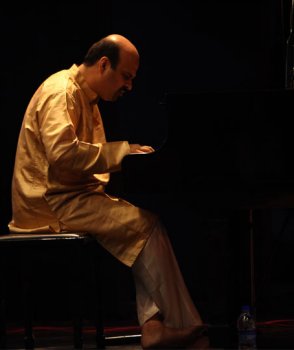 Anil Srinivasan 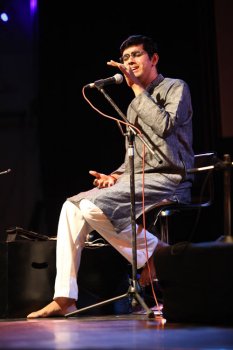 Sikkil Gurucharan Sadly, most of the audience left immediately after the kutcheri, and the auditorium was only partially-filled for remainder of the morning. Convener Dr. Anita Ratnam briefly summarized the previous day’s events and introduced Tribhuvan Maharaj, the grandson of the legendary Kathak maestro Pandit Birju Maharaj. Tribhuvan’s debut performance in Chennai showcased his potential as a performing artiste and as a torchbearer of his illustrious family’s artistic legacy. 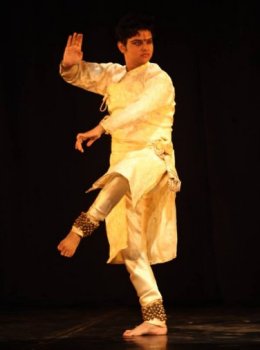 Tribhuvan Maharaj As the stage was being set for the next session, senior dance critic Leela Venkataraman briefly spoke about the “gender divide” in classical Indian dance. Sponsors and organizers are still apathetic towards promising male dancers in favor of the fairer sex. Moreover, the upholding of Section 377, an antiquated relic of colonialism, reinforces conventional views of gender and sexuality. Such outdated notions, she believes, will continue to negatively impact male dancers. Finally, she urged choreographers to avoid “creating pieces specifically for a female or male body” as they actually exacerbate the gender divide. 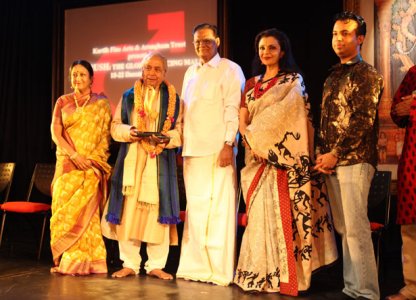 Padma Subrahmanyam, Pt Birju Maharaj, L Sabaratnem, Anita Ratnam, Hari Krishnan 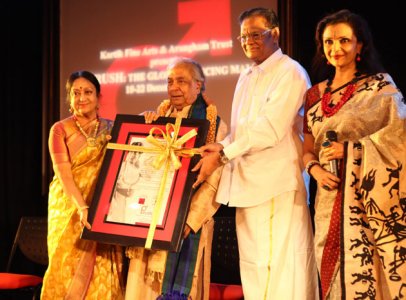 Pt Birju Maharaj gets lifetime achievement award Kartik Fine Arts honored Pandit Birju Maharaj with a lifetime achievement award. Senior dancer Dr. Padma Subrahmanyam shared anecdotes about her recent experiences of performing in a jugalbandhi with Maharaj. She commented him on his brilliant spontaneity and his childlike curiosity of everything around him. Maharaj also addressed the gathering, and with his characteristic charm, simply said that he is “still a student searching for new things.” He advised young dancers that sound knowledge in music is critical for developing bhava. Moreover, bhava must emanate from the body’s core and manifest in all parts of the body. Dr. Ratnam and L. Sabaretnam then gave the vote of thanks before proceeding to the last panel of the conclave. This fantastic panel, which focused on “contemporary Indian dance and the male dancer,” was skilfully moderated by Dr. Ratnam and featured four male dancers from four continents! It was very refreshing to hear each of the panelists speak so openly about their respective backgrounds and creative impulses. For example, Jay Pather’s choreography is profoundly influenced by his impoverished upbringing in South Africa during apartheid. Proudly “black in ideology and Indian by descent,” he has deliberately chosen to create work which resonates strongly with the post-apartheid issues of racial tension and male sexuality. Using a series of video clips, he also discussed his penchant for working with unusual spaces and for creating “men-centric” pieces which blend contemporary dance and classical ballet. In stark contrast, Sooraj Subramaniam, born and raised in Malaysia, was admittedly “privileged” in his upbringing and experiences as a dancer. Bolstered by a supportive family and several encouraging gurus, he initially worked as a contracted dancer in Britain before shifting to Belgium. Although a trained Bharatanatyam and Odissi dancer, he also worked closely with contemporary choreographers. In fact, he collaborated with Amsterdam-based choreographer Kalpana Raghuraman, and they premiered a new contemporary work, “Tightrope Walker,” in October 2013. The most intriguing part of his presentation was his original poem, which beautifully crystallized his artistic views on dance, creativity, and sexuality. 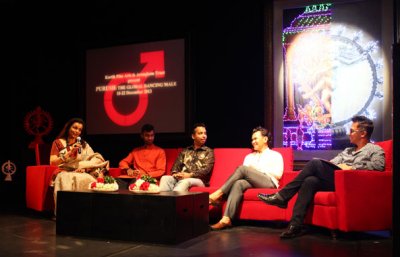 Anita Ratnam, Sooraj Subramaniam, Hari Krishnan, Ramli Ibrahim, Jay Pather  Sooraj Subramaniam 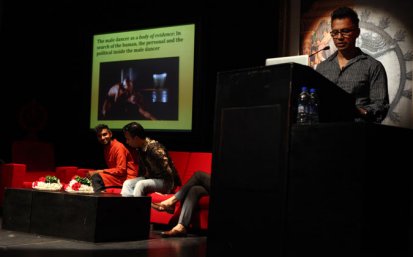 Jay Pather 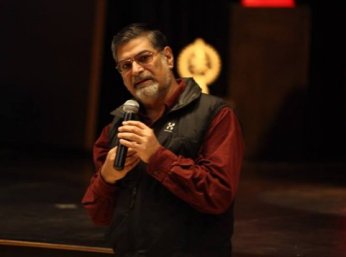 Rustom Bharucha Co-curator Hari Krishnan, based in Toronto, strives to subvert gender roles and to push the boundaries of sensuality and eroticism through his performance art. Krishnan is deeply inspired by multiculturalism and his in-depth study of the Tamil devadasis. Hence, several of his tongue-in-cheek choreographies feature rare Carnatic music compositions juxtaposed with anachronistic references to pop culture. The effect is often jarring, yet thought-provoking as Krishnan stated that the intention of his work is to critically examine “where [he] fits in” as an artiste. Ramli Ibrahim is also fascinated by multiculturalism, and he consciously creates art which celebrates Malaysia’s unique sense of modernity. Modern Malaysia’s diversity is directly reflected in Sutra Dance Foundation’s multiracial student body. In addition to Bharatanatyam and Odissi, students are also trained in modern dance as Ibrahim views it as a neutral technique which prepares the body for other styles of dance. He also firmly believes that the traditional Asian art exist in a continuum with contemporary art. Therefore, he incorporates indigenous art forms seamlessly in his modern work. His classical work, on the other hand, remains firmly rooted in Indian tradition, but he has modified the presentation to suit global audiences. The final morning session ended with some provocative commentary about the conclave by noted writer-director Rustom Bharucha. He was impressed that “loaded issues such as gender discrimination and sexuality” were discussed in such a “charged space" as he views Mylapore to be Chennai’s socially and artistically conservative cultural center. His main point of contention was that male sexuality was highlighted (to an extent) in this conclave, but equally important issues of caste were largely ignored. Nevertheless, he believes that conclaves like ‘Purush’ will ultimately help stimulate future discourse on the overwhelming issues that confront male dancers in India today. In hindsight, this year’s Natya Darshan had comparatively fewer morning sessions than in the previous conclaves. There was also a marked preference for performance as an object of critical analysis and discourse. Yet, this arrangement proved to be ideal as the schedule of events never felt taxing, and rasikas were able to witness an enviable variety of performance art over the past five days. There is no doubt that planning a conclave of this magnitude and professionalism is a remarkable achievement in Chennai. Therefore, special mention must be made to all the individuals who worked tirelessly behind the scenes to make everything so seamless. Dr. Ratnam must also be commended for her meticulous organizational skills and for her uncanny ability to bring such a diverse group of presenters and performers to Chennai. Kiran Rajagopalan, disciple of A. Lakshmanaswamy, is a Bharatanatyam dancer based in Chennai. |